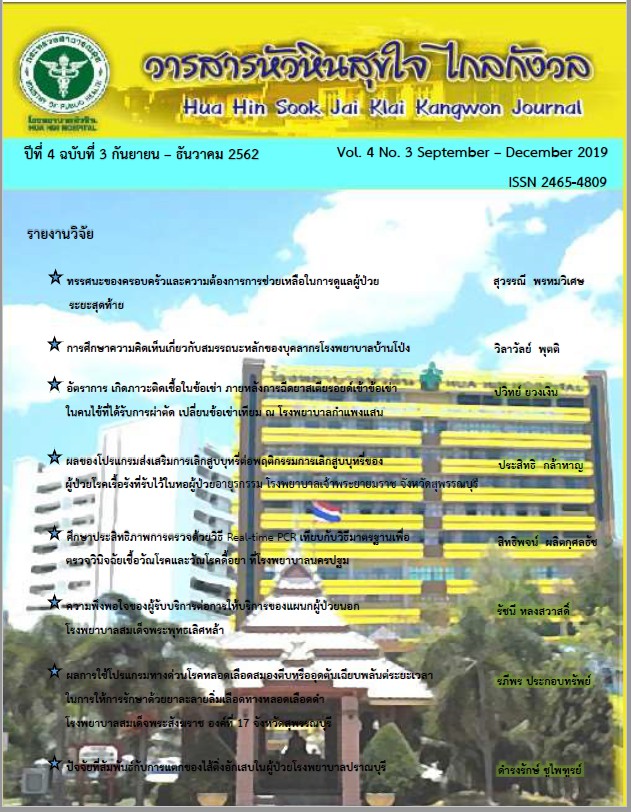Factors Associated with Ruptured Appendicitis in Patients at Pranburi Hospital
Keywords:
associated factors, rupture of appendix, appendicitis, patients of Pranburi Hospital, associated factors, rupture of appendix, appendicitis, patients of Pranburi HospitalAbstract
Research methodology: The aim of this retrospective study is to study on associated factors related to rupture of appendix in Pranburi Hospital patients. Medical records of 101 patients who were diagnosed with appendicitis and underwent surgery during October 1st, 2015 – July 31st, 2019 were collected. Descriptive statistics, chi–square test and multivariate logistic regression were used for data analysis. The p-value = 0.05 is considered statistically significant.
The result: showed that 27 out of 101 patients had ruptured appendicitis (26.7%) and 74 patients had appendicitis without ruptures (73.3%). Clinical characteristics were compared and found that migration of pain high body temperature (over 37.5 degrees Celsius), rebound tenderness at right lower quadrant and Alvarado Score of two groups were significantly different. Ruptured appendicitis group had more presence of migration of pain (P-value= 0.003), high body temperature (P-value= 0.051), rebound tenderness at right lower quadrant (P-value=0.025) and Alvarado Score (P-value ≤0.001) than the other group. There were no significantly different in Gender, age, lower abdominal pain, period of pain, vomiting, upset stomach, total leukocyte count, neutrophil count and waiting time before surgery between two groups. Multivariate logistic regression analysis indicated that potential risk factors or associated for rupture of appendix were the migration of pain (OR 6.69 P-value = 0.013) and rebound tenderness at right lower quadrant (OR 6.69 P-value = 0.076)
Suggestion: Patients with migration of pain and rebound tenderness at right lower quadrant should have surgical treatment as soon as possible to reduce risk of ruptured appendicitis.
References
2. สิทธิชัย วชิราศรีศิริกุล. ความยาวของไส้ติ่งกับการเกิดไส้ติ่งอักเสบฉับพลันในผู้ใหญ่. พุทธชินราชวารสาร 2555; 1: 86-90.
3. Humes DJ, Simpson J. Acute appendicitis. BMJ 2006; 333: 530-4.
4. Chong CF, Thien A, Mackie AJ, Tin AS, Tripathi S, Ahmad MA, Tan LT, Ang SH, Comparison of RIPASA and Alvarado scores for the diagnosis of acute appendicitis.Telisinghe PU.Singapore Med J. 2011 May; 52(5):340-5.
5. วิทูล กลับทวี, วิภาวี แสนศักดิ์, อรรจนา เขตสูงเนิน, ธรรมสรณ์ พิริยสุพงศ์. ความถูกต้องของ RIPASA และ Modified RIPASA score เปรียบเทียบกับ Alvarado score ในการวินิจฉัยผู้ป่วยที่สงสัยว่าเป็นโรคไส้ติ่งอักเสบเฉียบพลันและภาวะแทรกซ้อนจากโรคไส้ติ่งอักเสบ. ขอนแก่นเวชสาร 2554; 35: 41-50.
6. Frountzas M,Schizas D, Kontzoglou K, Toutouzas K. Research : Alvarado or RIPASA scorefordiagnosis of acute appendicitis?a meta-analysis of randomized trials.Int J Surg. 2018; 56: 307-314.
7. ข้อมูลผู้ป่วยโรคไส้ติ่งอักเสบ งานเวชระเบียนโรงพยาบาลปราณบุรี, 2562.
8.จีรพา โพธิ์พรม, The Alvarado Scoring System กับการวินิจฉัยโรคไส้ติ่งอักเสบเฉียบพลัน.
สวรรค์ประชารักษ์เวชสาร 2552; 6(3): 176-185.
9. พีรวัฒน์ ลิ้มมหาคุณ, ปัจจัยที่มีความสัมพันธ์กับการแตกของไส้ติ่งที่อักเสบในโรงพยาบาลพิมาย.
เวชสารโรงพยาบาลมหาราชนครราชสีมา 2559; 38(1): 35-40.
10. พงศกร อธิกเศวตพฤทธิ์ และยุวเรศ สิทธิชาญบัญชา, การศึกษาปัจจัยที่สัมพันธ์กับภาวะไส้ติ่งอักเสบแตกในผู้ป่วยไส้ติ่งอักเสบ ณ ห้องฉุกเฉิน โรงพยาบาลรามาธิบดี. ธรรมศาสตร์เวชสาร 2556; 13(1): 36 – 42.
11. พิเชษฐ พืดขุนทด, ความแม่นยำในการตรวจวินิจฉัยโรคไส้ติ่งอักเสบโดยใช้ระบบคะแนน Modified Alvarado ในโรงพยาบาลละหานทราย จังหวัดบุรีรัมย์. วารสารการแพทย์โรงพยาบาลศรีษะเกษ สุรินทร์ บุรีรัมย์ 2554; 26: 149-156.
12. ทวี ปุณณนิธิ และสิทธิโชค เลาหะวิลัย และ ศศิธร มงคลสวัสดิ์, ผลการรักษาภาวะไส้ติ่งอักเสบโดยการใช้ Alvarado score ในโรงพยาบาลขอนแก่น. วารสารการแพทย์โรงพยาบาลอุดรธานี 2561; 26(2): 93-98.
Downloads
Published
How to Cite
Issue
Section
License
บทความที่ได้รับการตีพิมพ์ในวารสารหัวหินเวชสาร เป็นลิขสิทธิ์ของโรงพยาบาลหัวหิน
บทความที่ลงพิมพ์ใน วารสารหัวหินเวชสาร ถือว่าเป็นความเห็นส่วนตัวของผู้เขียนคณะบรรณาธิการไม่จำเป็นต้องเห็นด้วย ผู้เขียนต้องรับผิดชอบต่อบทความของตนเอง







